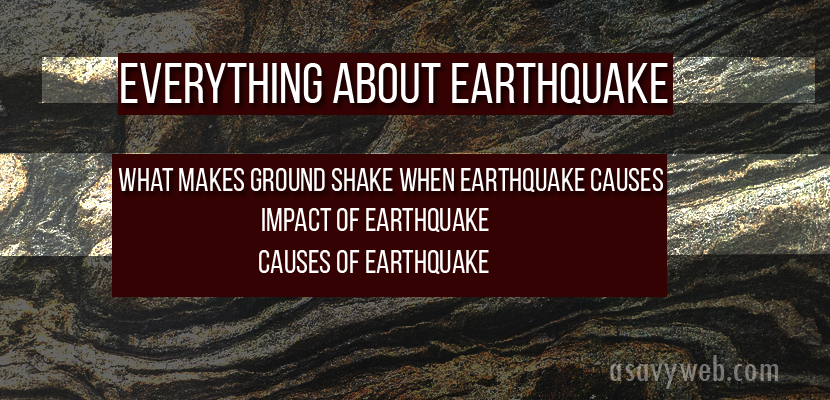Everything About Earthquake: Types, Impact, Measure and Earthquake Causes:
Earthquake is the unexpected shaking of the earth crust which causes earth’s crust cause stress or pressure to build up at points of weakness and rocks to deform and stored energy stored inside buildups in the same way as energy builds up in the spring of a watch when it is wound and when finally exceeds the strength of the rock and the rock fracture along a fault often at a zone existing weakness of within the rock and the stored energy is suddenly released as an earthquake and there are many damages done when earthquake causes.
What Makes Ground Shake When Earthquake Causes:
Intense vibrations, or seismic waves, spread out from the initial point of rupture, the focus, like ripples on a pond. These waves are what makes the ground shake and can travel large distances in all directions. Near the focus, the waves can be very large, making them extremely destructive.
Impact of Earthquake:
The impact of an earthquake is unanticipated and there is hardly any warning, making it impossible to predict and earthquake can kill people and destroy and vanish everything in fraction of seconds.
Earthquake is one of the most destructive natural threat. They may occur at any time of the year, day or night, with unexpected impact and little warning. They can destroy buildings and infrastructures in seconds, killing or injuring the inhabitants. Earthquake not only destroy the entire habitation but may de-stabilize the government, economy and social structure of the country.
Causes of earthquake:
The earth’s crust is a rocky layer of varying thickness ranging from a depth of about 10 kilometres under the continents. The crust is not a one piece but consists of sections called plates which vary in size from a few hundred to thousands of Kms. The theory of plate tectonics holds that the plates ride up on the more mobile mantle, and are driven by some yet unconfirmed mechanisms, perhaps thermal convection currents. When these plates contract each other, stress arises in the crust.
These stresses can be classified according to the type of movement along the plates boundaries:
1. Pulling away from each other.
2. Pushing against one another.
3. Sliding sideways relative to each other.
All these movements are associated with earthquakes.
The area of stress at plate boundaries which release accumulated energy by slipping or rupturing are known as faults. The theory of elasticity says that the crust is continuously stressed by the movement of the tectonic plates; it eventually reaches a point of maximum supportable strain. A rupture then occurs along the fault and the rock rebounds under its own elastic stress until the strain is relieved. The fault rupture triggers vibration called seismic (from the Greek seismos meaning shock or earthquake) waves, which radiates from the focus in all directions. The point of rupture is called the ‘focus’ and may be found near the surface or deep below it, the point on the surface directly above the focus is termed as the epicentre of the earthquake.
General characteristics of Earthquake:
Earthquake vibrations arise in a variety of frequencies and velocities. The real rupture process may last for a few seconds to as long as one minute for a major earthquake. The ground vibrations is caused by ‘body waves’ and surface wave
Body waves (P and S waves) pierce the body of the earth, vibrating fast. P waves travel about 6 kilometres per hour and S waves travel with a speed of 4 kilometres per hour
Surface waves vibrate the ground horizontally and vertically. These long period waves cause swaying of tall buildings and slight waves motion in bodies of water even at great distances from the epicentre.
Types of Earthquake:
Earthquake can be of 3 types based on the focal depth:
1. Deep: 300 to 700 kms from the earth surface
2. Medium: 60 to 300 kms
3. Shallow: less than 60 kms
The deep focus earthquakes are seldom destructive because by the time the waves reach the surface the impact reduces. Shallow focus earthquakes are more frequent and are extremely damaging because of their proximity to the surface.
Related Coverage Articles:
1. Caloris Basin Information or Mercury Carolis Plantia Characteristics: Gravity, Formation
2. Mercury Planet Information for Kids and Characteristics of Budh Planet
3. 1st Interstellar Asteroid Oumuamua 2017 U1 Discovered
4. 15 Interesting Mercury Planet Facts and Details
5. Can you live on Mercury Planet Surface?
How to Measure Earthquake
Measuring earthquakes:
Earthquakes can be explained by the use of two distinctively different scales of measurement demonstrating magnitude and intensity. Earthquake magnitude or amount of energy released is decided by the use of a seismograph which is an instrument that continuously records ground vibration. It was developed by a seismologist named Charles Richter. An earthquake with a magnitude 7.5 on the Richter scale releases 30 times the energy than that of one with 6.5 magnitudes. An earthquake of magnitude 3.0 is the smallest and normally felt by humans. The largest earthquake that has been recorded with this system is 9.25( in Alaska in 1969 and chile in 1960)
The 2nd type of scale, the earthquake intensity scale measures the effects of an earthquake where it occurs. The most widely used scale of this type was developed in 1902 by an Italian seismologist named Mercalli. The scale was extended and improved to suit the modern times. It is called the modified Mercalli scale, which expresses the intensity of earthquake effect on people, structure and the earth’s surface in vales from 1 to 7. With an intensity of 4 and below most of the people can feel the shakes and there are cracks on the walls, but with an intensity of 7 there is mostly panic with buildings collapsing totally and there is a total disruption in normal life.
Predictability:
Although some scientists claim capability to predict earthquakes, the methods are controversial. Accurate and exact predictions of such unexpected incidents are still not possible.

